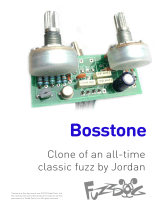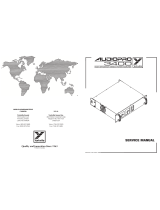Page is loading ...

Rodent
Gnawingly-good distortion
with switchable clipping
Contents of this document are ©2015 Pedal Parts Ltd.
No reproduction permitted without the express written
permission of Pedal Parts Ltd. All rights reserved.

Schematic
BOM
R1 1M
R2 1K
R3 560R
R4 47R*
R5 1K
R6 1K5
R7 1M
R8 10K
R9 47R
R10 10K
R11 10K
R12 1M
CLR 2K2
C1 22n
C2 1n
C3 100p
C4 33p
C5 4u7
C6 2u2
C7 4u7
C8 3n3
C9 22n
C10 1u
C11 100u
C12 47u
C13 47n
Q1 2N5458
IC LM308N
or OP07
D1 1N4001
FILT 100KA
DIST 100KA
VOL 100KA
RESP 1KB
D2,3 1N4148
D4,5 3mm Red LED
D6 1N4148**
* R4 goes in place of the RESPONSE pot if you’re going stock without the Ruetz mod.
See next page.
**CLIPPING DIODES - see next page

The power and signal pads on the PCB conform to the FuzzDog Direct Connection format,
so can be paired with the appropriate daughterboard for quick and easy offboard wiring.
Snap the small metal tag off the pots so they can be mounted flush in the box.
Pot mounts on the back side of the board, along with the toggle switch. You can use a
vertical-mount pot or just wire up ‘normal’ ones.
The striped leg (cathode) of the diode goes into the square pad.
The long leg (anode) of the electrolytic capacitors go into
the square pads.
RUETZ / RESPONSE MOD
The Ruetz mod flattens the frequency response of the circuit and gives you extended but
tight low end. You can simply leave out R4 and C6 if you want to have this non-adjustable
and permanent. However, its more rewarding to make it adjustable. To do this add either
the RESPONSE pot (1KB) or put a 1K trimmer in T1. Now twiddle until you get the result
you want.
To make a stock circuit without the mod,
place R4 (47R) across the RESPONSE
pads like this:
1 2 3
PCB Layout ©2014 Pedal Parts Ltd.

CLIPPING DIODES
There are two sets of clipping diode pads on the board, along with pads for an optional
clipping selection switch.
Stock clipping:
Standard Rodent: D2-3 1N4148
Turbo Rodent: D4-5 3mm Red LEDs
You Dirty Rodent: D2-3 1N34A
Notice there’s an extra spot - D6. You can add an extra diode along with
D2-3 to get asymetrical clipping. It doesn’t have to be 1N4148. Mix and match.
Experiment with different diode combinations in any of the spots and find your own
favourite.
NOTE: YOU MUST PUT A JUMPER WIRE ACROSS D6
IF YOU AREN’T USING IT FOR A DIODE.
If you’re using the diode selection switch, just put a
SPDT ON-ON switch in there. If you’re making a 3-
knob version you can’t put the switch directly into the
pads - you’ll have to wire it offboard and place it as
shown >>>
HARD WIRING A SINGLE CLIPPING OPTION
If you want to dispense with the clipping switch you’ll have to place a jumper wire across
the switch pads, depending on which set of diode pads you’re using.
RED for D4-5
BLUE for D2-3(-6)

POT CONFIGURATIONS
There are two spots for the FILTER pot.
Use one or the other depending on
whether you’re making a 3 or 4 pot version.

Test the board!
UNDER NO CIRCUMSTANCES will troubleshooting help
be offered if you have skipped this stage. No exceptions.
Once you’ve finished the circuit it makes sense to test is before
starting on the switch and LED wiring. It’ll cut down
troubleshooting time in the long run. If the circuit works at this
stage, but it doesn’t once you wire up the switch - guess what?
You’ve probably made a mistake with the switch.
Solder some nice, long lengths of wire to the board connections for
9V, GND, IN and OUT. Connect IN and OUT to the jacks as shown.
Connect all the GNDs together (twist them up and add a small
amount of solder to tack it). Connect the battery + lead to the 9V
wire, same method. Plug in. Go!
If it works, crack on and do your switch wiring. If not... aw man.
At least you know the problem is with the circuit. Find out why, get
it working, THEN worry about the switch etc.
BATTERY
IN OUT
Your nice, new circuit board
INCLUDING WIRED POTS!!!!
IN 9V GND OUT

(if using a daughterboard please refer to the relevant document)
Wire it up - DC only version
This circuit is standard, Negative GND. Your power supply should be
Tip Negative / Sleeve Positive. That’s the same as your standard pedals
(Boss etc), and you can safely daisy-chain your supply to this pedal.
The BOARD GND connections don’t all have to connect to one point.
They can be daisy-chained around the circuit, using larger connection
points (such as jack socket lugs) for multiple connections. As long as
they all connect together in some way.
L
E
D
BOARD
OUT
BOARD
9V
BOARD
GND
BOARD
GND
BOARD
GND
BOARD
INPUT
+
IN
OUT
L
E
D
BOARD
GND
BOARD
LED+

(if using a daughterboard please refer to the relevant document)
Wire it up - with battery
This circuit is standard, Negative GND. Your power supply should be
Tip Negative / Sleeve Positive. That’s the same as your standard pedals
(Boss etc), and you can safely daisy-chain your supply to this pedal.
The BOARD GND connections don’t all have to connect to one point.
They can be daisy-chained around the circuit, using larger connection
points (such as jack socket lugs) for multiple connections. As long as
they all connect together in some way.
PedalParts.co.uk
Just because my pre-drilled
enclosure doesn’t
accommodate a battery, it
doesn’t mean you can’t add
one yourself in a bigger box.
Follow this!
L
E
D
BOARD
OUT
BOARD
9V
BOARD
GND
BOARD
GND
BOARD
GND
BOARD
INPUT
BATTERY
+
IN
OUT
L
E
D
BOARD
GND
BOARD
LED+
+
/











